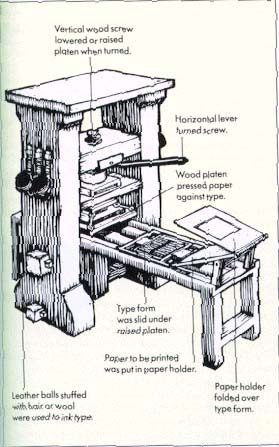
The productive years
In 1449 or 1450 Gutenberg received from Fust a loan of 800 guilders, carrying interest at six percent, to be used in completing his work on his apparatus, this being pledged to Fust as security. After a short period of time, it appeared that 800 guilders were not enough, so Gutenberg applied for a further loan. Fust obviously declined in the offer, but offered instead to advance in Gutenberg another 800 guilders, on the condition of being taken into partnership with them for "the work of the books". (Scholderer 14).
During the time that Gutenberg was printing, he came up with the most efficient and cheap way of printing. The book that was undertaken was the 42-line Bible, in which one style of type is used without the entire book, therefore saving on costs. He has been further accredited with an edition of an immense Latin Dictionary and encyclopedia and the Catholicon of Joannes Balbus, which states principles of Catholisicm in a condensed version (Scholderer 18).
Gutenberg printed two books in his lifetime the 42 line Bible and the Catholicon by Balbus. The Catholicon was an enormous encyclopedia: 748 pages in two columns of 66 lines each (guten), Many years of Gutenberg's life are lost to history, but in 1450 he was back in Mainz at work on a printing press. Some historians believed that the ideas that got Gutenberg started in development for the printing press, were originally from China, and someone brought tales of this machine, because no one had seen China directly, until the time of Marco Polo. More likely is the fact that tales of this invention were passed along from town to town across Asia and then Europe. Another distinct possibility is that Gutenberg's invention of the movable type was his original idea, a thought that some historians. To add to the confusion, much of the detials of Gutenberg's life are still unknown(guten)






